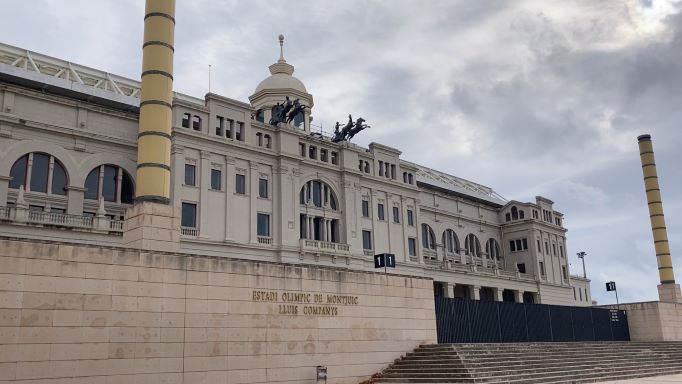Boycotts, ruins, and Games: History of Barcelona’s Olympic Stadium

Barcelona’s Olympic Stadium, the Estadi Lluís Companys as it’s officially known, was at the heart of the summer Games held in the Catalan capital in 1992. It was the centerpiece of one of the world’s biggest sporting events that would change the city of Barcelona forever.
However, the sports venue has a storied history that goes far beyond the 1992 Olympic Games. It was first built almost an entire century ago, and since then has been at the heart of alternative Olympic idea to boycott the Nazis, many La Liga football games and many more to come, as well as concerts of some of the biggest artists on the planet.
The Olympic Stadium was built in 1929 for the International Exposition in Barcelona, aimed at promoting the architecture and advances in technology in Catalonia in the early 20th century. The event allowed for several iconic buildings to be constructed, such as the National Art Museum of Catalonia building, the Magic Fountain, and the Teatre Grec.
The Expo brought about “major changes for the area of Montjuïc all the way down to Plaça Espanya,” as explained to Catalan News by the director of the Olympic Ring, Carmen Lanuza. The Olympic Ring is the set of facilities and venues located on the hill of Montjuïc in Barcelona which also includes an open-air pool with spectacular views of the city, and the pavilion known today as Palau Sant Jordi.
At the time of its construction, it was one of the biggest stadiums in Europe, capable of fitting around 67,000 fans. “It represented growth for Barcelona, which aspired at the time to host an Olympic Games, but this never happened because of the Civil War,” Lanuza said.
People's Olympics, anti-Nazi boycott
The Olympic Games of 1936 were held in Berlin, then under the reign of Adolf Hitler. As a form of protest, the Spanish Republic organized an alternative anti-fascist People's Olympics and encouraged other nations to boycott the Games in Nazi Germany.
However, these plans were upended by the outbreak of the Spanish Civil War, which started in the same summer. Many athletes who traveled initially to take part in these Games stayed to join the International Brigades and fight for the Republican cause.
The war gave the Olympic Stadium another entirely new purpose. The Olympic Stadium served as a place to accommodate around 2,000 displaced people from the Catalan capital during the war, exemplifying the very different eras the facility has gone through.
People affected by the war slept there, ate there, and children were even schooled there. From its very beginnings, it was a structure with the purpose of serving the people of Barcelona.
Deterioration and reconstruction
The structure fell into disrepair during the Franco dictatorship, which began in 1939 after the nationalist forces took power following the Civil War. “It wasn’t a time that the Olympic Stadium had much use, little by little, it started deteriorating,” the director of the Olympic Ring facilities told us.
Neglect and a lack of maintenance left the stadium in a state of ruin, although the facility was still used for some youth sporting activities throughout these decades.
1992 changed everything for the Olympic Stadium. When the Catalan capital was chosen as the host city in 1986, part of the project was to renovate the ground into something capable of putting on one of the greatest shows in the world.
Lanuza says that the Catalan Joan Antoni Samaranch, then-president of the International Olympic Committee, gave the city and its Olympic facilities a shot in the arm. “He put Barcelona on the map by helping win the rights to host the Olympics.”
The facility was cleaned up, modernized, and the pitch and surrounding running track was lowered 11 meters deeper to allow for a higher capacity of fans in the stadium. Its new splendor was revealed to the world in the Opening ceremony, which featured a performance of Freddie Mercury and Montserrat Caballé’s anthem ‘Barcelona,’ sung by Caballé and Josep Carreras, as the legendary charismatic Queen frontman had passed away just months earlier. Another of the many highlights of this opening ceremony was Paralympian Antonio Rebollo’s flaming arrow lighting up the Olympic cauldron.
Legacy since 1992
A recent report from the International Olympic Committee says that over 90% of the facilities used in the Barcelona Games of 1992 are still in use, setting an example for the rest of the world as a model to follow.
In recent times, the Estadi Lluís Companys has not been in use on a weekly basis, but it does regularly hold concerts by some of the biggest names in music. Bruce Springsteen, AC/DC, and The Rolling Stones are just some of the huge international names to have performed at the open-air venue. “We’re one of the stops on world tours of some of the biggest international artists,” Lanuza pointed out.
It has also been the venue for various sporting events, something that will happen with much more regularity from 2023 when it becomes the temporary home of one of the biggest football clubs in the world, FC Barcelona, while renovation works are being undertaken at the Camp Nou.
The stadium has also been the home of the Barcelona Dragons American football team and La Liga side Espanyol for more than a decade while their current RCDE stadium was under construction.